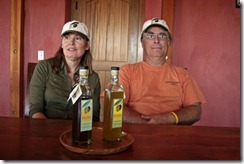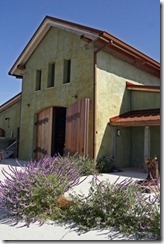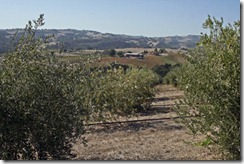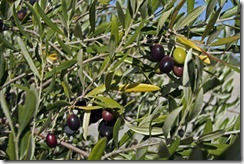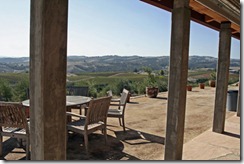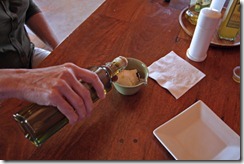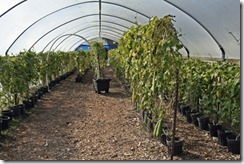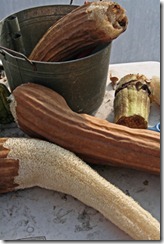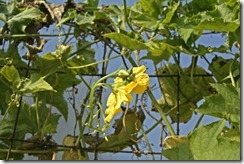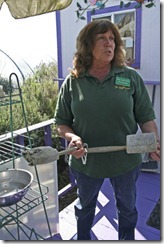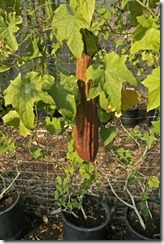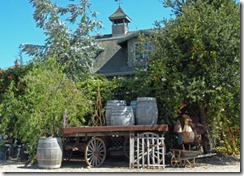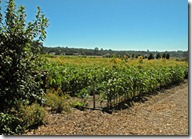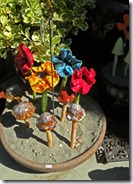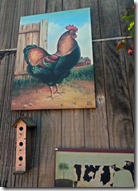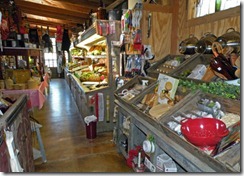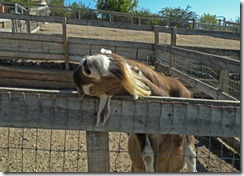 Something got your goat? Not at Happy Acres Family Farm. Goats are what it is all about at Happy Acres, a state licensed, certified organic dairy goat farm. More than 200 of them rest under shade trees, munch alfalfa in enclosures, or roam in the grasses with the alpacas.
Something got your goat? Not at Happy Acres Family Farm. Goats are what it is all about at Happy Acres, a state licensed, certified organic dairy goat farm. More than 200 of them rest under shade trees, munch alfalfa in enclosures, or roam in the grasses with the alpacas. 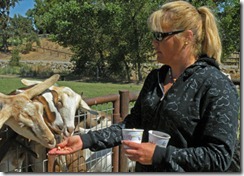 Stephanie Simonin is the goat lady, and her business has grown from one sweet goat named Stella, who Simonin brought in some years ago to help feed calves who had lost their moms. Stella still lives here along with an assortment of animals who share the farm. There are mini-teacup pigs, miniature horses, regular sized horses, a miniature donkey, a cow, alpacas,
Stephanie Simonin is the goat lady, and her business has grown from one sweet goat named Stella, who Simonin brought in some years ago to help feed calves who had lost their moms. Stella still lives here along with an assortment of animals who share the farm. There are mini-teacup pigs, miniature horses, regular sized horses, a miniature donkey, a cow, alpacas,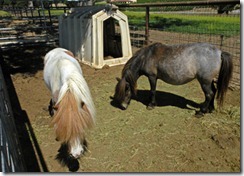 a goose, cats, kittens, small dogs and really big dogs. All the animals get a name and the goats have tags on collars around their necks so you can see what those names are and be properly introduced. Simonin, her mom, Laurie, her sister, and all the kids take part in running the farm.
a goose, cats, kittens, small dogs and really big dogs. All the animals get a name and the goats have tags on collars around their necks so you can see what those names are and be properly introduced. Simonin, her mom, Laurie, her sister, and all the kids take part in running the farm. In 2009, Simonin completed work on a large farm stand that sits at the entrance to the property. When you first drive up two huge Burmese Mountain dogs greet you enthusiastically. If you should happen to 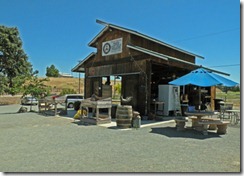 bring your pet along, Simonin requests that you leave the pooch in the car while you visit.
bring your pet along, Simonin requests that you leave the pooch in the car while you visit.
 bring your pet along, Simonin requests that you leave the pooch in the car while you visit.
bring your pet along, Simonin requests that you leave the pooch in the car while you visit. The stand contains cheese, ice cream, eggs from free-range chickens, and certified organic fresh produce. Happy Acres offers a line of skin care products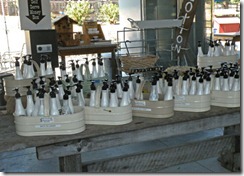 made from the milk at both the stand and online. The products include moisturizer, facial cleanser, lip butter, eye cream, and soap bars. Eczema, psoriasis, and acne are helped by products like these. They also contain vitamins A, B, and K, amino acids, magnesium, potassium, and phosphorous and are paraben free.
made from the milk at both the stand and online. The products include moisturizer, facial cleanser, lip butter, eye cream, and soap bars. Eczema, psoriasis, and acne are helped by products like these. They also contain vitamins A, B, and K, amino acids, magnesium, potassium, and phosphorous and are paraben free.
 made from the milk at both the stand and online. The products include moisturizer, facial cleanser, lip butter, eye cream, and soap bars. Eczema, psoriasis, and acne are helped by products like these. They also contain vitamins A, B, and K, amino acids, magnesium, potassium, and phosphorous and are paraben free.
made from the milk at both the stand and online. The products include moisturizer, facial cleanser, lip butter, eye cream, and soap bars. Eczema, psoriasis, and acne are helped by products like these. They also contain vitamins A, B, and K, amino acids, magnesium, potassium, and phosphorous and are paraben free. 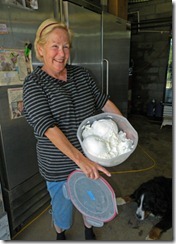 Simonin’s Mom, Laurie produces all the lotions and cheeses. The cheese production area is located in the milking barn. Large batches are produced for restaurants in the area. “We were asked by one of the Italian restaurants to make an Italian cheese,” Laurie commented as she pointed to a cooler stocked with two sizes of oblong shaped cheeses. “Most cheeses are French. This is Toma,” she explained, “made with no culture.”
Simonin’s Mom, Laurie produces all the lotions and cheeses. The cheese production area is located in the milking barn. Large batches are produced for restaurants in the area. “We were asked by one of the Italian restaurants to make an Italian cheese,” Laurie commented as she pointed to a cooler stocked with two sizes of oblong shaped cheeses. “Most cheeses are French. This is Toma,” she explained, “made with no culture.” Some of the other cheeses are Fresh Chevre with herbs that are grown locally, one with Sundried Tomatoes, Parmetta, which would be used as you would Parmesan, and Feta. “Some are made without salt and some with,” Laurie said.
While goat milk is well known to be good for those who are lactose intolerant, Simonin commented that she discovered the benefits of drinking goat milk first hand. Not soon after one of her children, who suffered seasonal allergies, began drinking it, the condition cleared up. “No more sinus or runny nose,” she said.
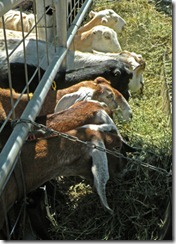 While Laurie produces the products, Simonin is in charge of the goats, performing milking chores twice a day. Her sister and the kids also pitch in and have chores like giving Lucy the cow her bottle feeding. Lucy is actually still a calf and requires milk along with feed. This is just one of the rescue animals that have come to live at Happy Acres. The calf had been mistreated to
While Laurie produces the products, Simonin is in charge of the goats, performing milking chores twice a day. Her sister and the kids also pitch in and have chores like giving Lucy the cow her bottle feeding. Lucy is actually still a calf and requires milk along with feed. This is just one of the rescue animals that have come to live at Happy Acres. The calf had been mistreated to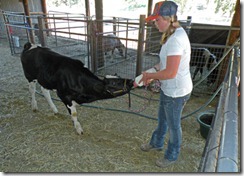 the extent that she still is not quite as well socialized as she should be, but with tender care at Happy Acres she is beginning to trust her new owners. A cow is useful on the farm especially during the time that the goats give birth. The kids often need a supplement of milk and Lucy will be beneficial at that time.
the extent that she still is not quite as well socialized as she should be, but with tender care at Happy Acres she is beginning to trust her new owners. A cow is useful on the farm especially during the time that the goats give birth. The kids often need a supplement of milk and Lucy will be beneficial at that time. Simonin breeds the goats once a year and relies on the blood line and talents of Scotty, the Billy goat among others. Scotty roams the back pasture along with an assortment of goats and two black alpacas. The alpacas were also rescue animals, and they perform a valuable service. The farm is located in the countryside of Templeton and it is not uncommon for there to be mountain lions, 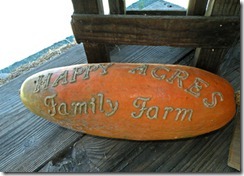 coyotes, and foxes about. Even neighborhood dogs are a threat. When a threat is perceived, the alpacas give out a high-pitched sound and immediately go on alert. They herd the goats back behind them and prance forward, shrilling their call as a warning to whatever predator might be trying to gain entrance to the field.
coyotes, and foxes about. Even neighborhood dogs are a threat. When a threat is perceived, the alpacas give out a high-pitched sound and immediately go on alert. They herd the goats back behind them and prance forward, shrilling their call as a warning to whatever predator might be trying to gain entrance to the field.
 coyotes, and foxes about. Even neighborhood dogs are a threat. When a threat is perceived, the alpacas give out a high-pitched sound and immediately go on alert. They herd the goats back behind them and prance forward, shrilling their call as a warning to whatever predator might be trying to gain entrance to the field.
coyotes, and foxes about. Even neighborhood dogs are a threat. When a threat is perceived, the alpacas give out a high-pitched sound and immediately go on alert. They herd the goats back behind them and prance forward, shrilling their call as a warning to whatever predator might be trying to gain entrance to the field. Another nice element of having alpacas is that they produce a fine, soft wool that is spun into yarn for making clothing. The yarn is sold at the farm stand and the funds are donated to charities that the kids choose.
Tours of the farm are available by appointment consisting of learning how to milk, and blending your own cheese, which you ge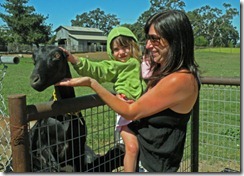 t to take home, bottle feeding baby goats when they are born, and feeding peanuts to the goat herd. Tours last one and half to two hours long and cost $25 for adults and $12 for children. Happy Acres offers discounts for school groups. Call Stephanie at (805) 434-7580 for an appointment.
t to take home, bottle feeding baby goats when they are born, and feeding peanuts to the goat herd. Tours last one and half to two hours long and cost $25 for adults and $12 for children. Happy Acres offers discounts for school groups. Call Stephanie at (805) 434-7580 for an appointment.
 t to take home, bottle feeding baby goats when they are born, and feeding peanuts to the goat herd. Tours last one and half to two hours long and cost $25 for adults and $12 for children. Happy Acres offers discounts for school groups. Call Stephanie at (805) 434-7580 for an appointment.
t to take home, bottle feeding baby goats when they are born, and feeding peanuts to the goat herd. Tours last one and half to two hours long and cost $25 for adults and $12 for children. Happy Acres offers discounts for school groups. Call Stephanie at (805) 434-7580 for an appointment. Happy Acres Family Farm products are sold at Farmers Markets in Morro Bay, Templeton, Baywood Park, and Avila Beach. They are also available at area stores and the cheeses are featured in recipes in dozens of restaurants. You can find their lotion products for sale online at www.happyacresfamilyfarm.net .
A visit to Happy Acres Family Farm is sure NOT to get your goat!
